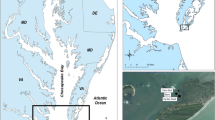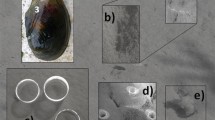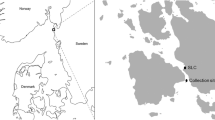Abstract
Suspension-feeding bivalves increase the quantity and quality of sedimenting organic matter through the production of faeces and pseudofaeces that are remineralised in coastal sediments and thus increase sediment oxygen demand and nutrient regeneration. Bivalves are intensively cultivated worldwide; however, no bivalve biodeposit decay rates are available to parameterise models describing the environmental effects of bivalve culture. We examined sediment biogeochemical changes as bivalve biodeposits age by incubating coastal sediments to which we added fresh mussel (Perna canaliculus) biodeposits and measured O2 and nutrient fluxes as well as sediment characteristics over an 11-day period. Biodeposits elevated organic matter, chlorophyll a, phaeophytin a, organic carbon and nitrogen concentrations in the surface sediments. Sediment oxygen consumption (SOC) increased significantly (P=0.016) by ∼1.5 times to 1,010 μmol m−2 h−1 immediately after biodeposit addition and remained elevated compared to control cores without additions for the incubation period. This increase is in the range of observed in situ oxygen demand enhancements under mussel farms. To calculate a decay rate for biodeposits in sediments we fitted a first-order G model to the observed increase in SOC. The significant model fit (P=0.001, r 2=0.72) generated a decay rate of 0.16 day−1 (P=0.033, SE=0.05) that corresponds to a half-life time of 4.3 day. This decay rate is 1–2 orders of magnitude higher than published decay rates of coastal sediments without organic enrichment but similar to rates of decaying zooplankton faecal pellets. NH +4 release increased rapidly on the day of biodeposit addition (P=0.013) and reached a maximum of 144 μmol m−2 h−1 after 5 days which was 3.6 times higher compared to control cores. During this period NH +4 release was significantly (P<0.001 to P=0.043) higher in the cores with biodeposit additions than in control cores.




Similar content being viewed by others
References
Arar EJ, Collins GB (1997) In vitro determination of chlorophyll a and pheophytin a in marine and freshwater algae by fluorescence. National Exposure Research Laboratory, Office of Research and Development, U.S. Environmental Protection Agency
Bacher C, Bioteau H, Chapelle A (1995) Modelling the impact of a cultured oyster population on the nitrogen dynamics: the Thau Lagoon case (France). Ophelia 42:29–54
Chapelle A, Menesguen A, Deslous-Paoli J-M, Souchu P, Mazouni N, Vaquer A, Millet B (2000) Modelling nitrogen, primary production and oxygen in a Mediterranean lagoon. Impact of oysters farming and inputs from the watershed. Ecol Model 127:161–181
Christensen PB, Glud RN, Dalsgaard T, Gillespie P (2003) Impacts of longline mussel farming on oxygen and nitrogen dynamics and biological communities of coastal sediments. Aquaculture 218:567–588
van Duyl FC, van Raaphorst W, Kop AJ (1993) Benthic bacterial production and nutrient sediment–water exchange in sandy North Sea sediments. Mar Ecol Prog Ser 100:85–95
Enoksson V (1993) Nutrient recycling by coastal sediments: effects of added algal material. Mar Ecol Prog Ser 92:245–254
Fabiano M, Danovaro R, Olivari E, Misic C (1994) Decomposition of faecal matter and somatic tissue of Mytilus galloprovincialis: changes in organic matter composition and microbial succession. Mar Biol 119:375–384
Garber JH (1984) 15N tracer study of the short-term fate of particulate organic nitrogen at the surface of coastal marine sediments. Mar Ecol Prog Ser 16:89–104
Giles H, Pilditch CA (2004) Effects of diet on sinking rates and erosion thresholds of mussel Perna canaliculus biodeposits. Mar Ecol Prog Ser 282:205–219
Graf G, Bengtsson W, Diesner U, Schulz R, Theede H (1982) Benthic response to sedimentation of a spring phytoplankton bloom: process and budget. Mar Biol 67:201–208
Grenz C, Hermin M-N, Baudinet D, Daumas R (1990) In situ biochemical and bacterial variation of sediments enriched with mussel biodeposits. Hydrobiologia 207:153–160
Hansen B, Fotel FL, Jensen NJ, Madsen SD (1996) Bacteria associated with a marine planktonic copepod in culture. II. Degradation of fecal pellets produced on a diatom, a nanoflagellate or a dinoflagellate diet. J Plankton Res 18:275–288
Hargrave BT (1976) The central role of invertebrate faeces in sediment decomposition. In: Anderson JM, Macfayden A (eds) The role of terrestrial and aquatic organisms in decomposition processes. Blackwell, Great Britain, pp 301–321
Harris JM (1993) The presence, nature and role of gut microflora in aquatic invertebrates: a synthesis. Microb Ecol 25:195–231
Hatcher A, Grant B, Schofield B (1994) Effects of suspended mussel culture (Mytilus spp.) on sedimentation, benthic respiration and sediment nutrient dynamics in a coastal bay. Mar Ecol Prog Ser 115:219–235
Hawkins AJS, James MR, Hickman RW, Hatton S, Weatherhead M (1999) Modelling of suspension-feeding and growth in the green-lipped mussel Perna canaliculus exposed to natural and experimental variations of seston availability in the Marlborough Sounds, New Zealand. Mar Ecol Prog Ser 191:217–232
Henderson A, Gamito S, Karakassis I, Pederson P, Smaal A (2001) Use of hydrodynamic and benthic models for managing environmental impacts of marine aquaculture. J Appl Ichthyol 17:163–172
Herbert RA (1999) Nitrogen cycling in coastal marine ecosystems. FEMS Microbiol Rev 23:563–590
Ingalls AE, Aller RC, Lee C, Sun M-Y (2000) The influence of deposit-feeding on chlorophyll-a degradation in coastal marine sediments. J Mar Res 58:631–651
Jeffs AG, Holland RC, Hooker SH, Hayden BJ (1999) Overview and bibliography of research on the Greenshell mussel, Perna canaliculus, from New Zealand waters. J Shellfish Res 18:347–360
Kaspar HF, Gillespie PA, Boyer IC, MacKenzie AL (1985) Effects of mussel aquaculture on the nitrogen cycle and benthic communities in Kenepuru Sound, Marlborough Sounds, New Zealand. Mar Biol 85:127–136
Kautsky N, Evans S (1987) Role of biodeposition by Mytilus edulis in the circulation of matter and nutrients in a Baltic coastal ecosystem. Mar Ecol Prog Ser 38:201–212
Kelly JR, Nixon SR (1984) Experimental studies of the effect of organic deposition on the metabolism of a coastal marine bottom community. Mar Ecol Prog Ser 17:157–169
Kristensen E, Blackburn TH (1987) The fate of organic carbon and nitrogen in experimental marine sediment systems: Influence of bioturbation and anoxia. J Mar Res 45:231–257
Kristensen E, Holmer M (2001) Decomposition of plant materials in marine sediment exposed to different electron acceptors (O2, NO −3 , and SO 2−4 ), with emphasis on substrate origin, degradation kinetics, and the role of bioturbation. Geochim Cosmochim Acta 65:419–433
Kristensen E, Mikkelsen OL (2003) Impact of the burrow-dwelling polychaete Nereis diversicolor on the degradation of fresh and aged macroalgal detritus in a coastal marine sediment. Mar Ecol Prog Ser 265:141–153
Mazouni N, Gaertner J-C, Deslous-Paoli J-M, Landrein S, d’Oedenberg MG (1996) Nutrient and oxygen exchanges at the water–sediment interface in a shellfish farming lagoon (Thau, France). J Exp Mar Biol Ecol 205:91–113
Newell RIE (2004) Ecosystem influences of natural and cultivated populations of suspension-feeding bivalve molluscs: a review. J Shellfish Res 23:51–61
Newell RIE, Cornwell JC, Owens MS (2002) Influence of simulated bivalve biodeposition and microphytobenthos on sediment nitrogen dynamics: a laboratory study. Limnol Oceanogr 47:1367–1379
Porter ET, Cornwell JC, Sanford LP (2004) Effect of oysters Crassostrea virginica and bottom shear velocity on benthic–pelagic coupling and estuarine water quality. Mar Ecol Prog Ser 271:61–75
Redfield AC (1934) On the proportions of organic derivatives in sea water and their relation to the composition of plankton. In: Daniel RJ (ed) James Johnstone Memorial Volume. University Press, Liverpool, pp 176–192
Singer JK, Anderson JB, Ledbetter MT, McCave IN, Jones KPN, Wright R (1988) An assessment of analytical techniques for the size analysis of fine-grained sediments. J Sediment Petrol 58:534–543
Stuart V, Newell RC, Lucas MI (1982) Conversion of kelp debris and faecal material from the mussel Aulacomya ater by marine micro-organisms. Mar Ecol Prog Ser 7:47–57
Sun M-Y, Lee C, Aller RC (1993) Laboratory studies of oxic and anoxic degradation of chlorophyll-a in Long Island Sound sediments. Geochim Cosmochim Acta 57:147–157
Tenore KR, Boyer LF, Cal RM, Corral J, Garcia-Fernandez C, Gonzalez N, Gonzalez-Gurriaran E, Hanson RB, Iglesias J, Krom M, Lopez-Jamar E, McClain J, Pamatmat MM, Perez A, Rhoads DC, de Santiago G, Tietjen J, Westrich J, Windom HL (1982) Coastal upwelling in the Rias Bajas, NW Spain: contrasting the benthic regimes of the Rias de Arosa and de Muros. J Mar Res 40:701–772
Urban-Rich J (1999) Release of dissolved organic carbon from copepod fecal pellets in the Greenland Sea. J Exp Mar Biol Ecol 232:107–124
Verardo DJ, Froelich PN, McIntyre A (1990) Determination of organic carbon and nitrogen in marine sediments using the Carlo Erba NA-1500 analyzer. Deep-Sea Res 37:157–165
Westrich JT, Berner RA (1984) The role of sedimentary organic matter in bacterial sulfate reduction: the G model tested. Limnol Oceanogr 29:236–249
Wotton RS, Malmqvist B (2001) Feces in aquatic ecosystems. BioScience 51:537–544
Acknowledgements
We thank D. Bell for help in the field and D. and M. Aislabe for access to their mussel farm. We also thank K. Vopel for suggestions on an earlier version of this manuscript. A University of Waikato postgraduate scholarship funded the first author; this is gratefully acknowledged.
Author information
Authors and Affiliations
Corresponding author
Additional information
Communicated by G.F. Humphrey, Sydney
Rights and permissions
About this article
Cite this article
Giles, H., Pilditch, C.A. Effects of mussel (Perna canaliculus) biodeposit decomposition on benthic respiration and nutrient fluxes. Mar Biol 150, 261–271 (2006). https://doi.org/10.1007/s00227-006-0348-7
Received:
Accepted:
Published:
Issue Date:
DOI: https://doi.org/10.1007/s00227-006-0348-7




